Retrofit of Residential Buildings in Europe
Abstract
:1. Introduction
2. Materials and Methods
2.1. Sample Size
2.2. Data Collection
2.3. Data Analysis
- Absorption: the intervention completely covers and absorbs the existing building or the new part is contained within the volume of the existing building.
- Continuity: the intervention presents no sharp rift with the language of the existing building in terms of shape, dimensions, or architectural features.
- Contrast: the intervention presents marked differences from the existing building in terms of shape, dimensions, and technological or architectural features.
- Filling: the intervention fills a gap between two or more buildings or between different parts of the same building.
- Integration: the intervention and the existing building collaborate and integrate to shape a new overall image and perception of construction.
- Parasite: the intervention forces the creation of temporary or permanent relationships with the host building in order to be completed.
- Rebalancing: the intervention acts as a counterbalance for the existing building, creating an overall equilibrium in the new perception.
- Remodeling: the intervention operates a substantial modification on the original building that results in drastic transformation.
- Selection: the intervention works through punctual and specified action to upgrade the features of the existing building.
- Stratification: the intervention acts as an additive layer, with different possible depths, modifying the original architectural features and performances of the existing building.
3. Results
4. Discussion
Funding
Acknowledgments
Conflicts of Interest
References
- Pasqualis, B. Case temporanee. In Strategie Innovative per L’emergenza Abitativa Post-Terremoto; FrancoAngeli: Milan, Italy, 2014. [Google Scholar]
- Burton, E.; Jenks, M.; Williams, K. Achieving Sustainable Urban Form; Routledge: London, UK, 2013. [Google Scholar]
- Burton, E.; Jenks, M.; Williams, K. The Compact City: A Sustainable Urban Form? Routledge: London, UK, 2003. [Google Scholar]
- Hagan, S. Cities of field: Cyberspace and urban space. Architecture, city, environment. In Proceedings of the PLEA 2000, Cambridge, UK, 2–5 July 2000. [Google Scholar]
- McLaren, D. Compact or dispersed? Dilution is no solution. Built Environ. 1992, 1, 268–284. [Google Scholar]
- Jabareen, Y.R. Sustainable urban forms: Their typologies, models, and concepts. J. Plan. Educ. Res. 2006, 26, 38–52. [Google Scholar] [CrossRef]
- Williams, K. Does intensifying cities make them more sustainable. In Achieving Sustainable Urban Form; Burton, B., Jenks, M., Williams, K., Eds.; Spon Press: London, UK, 2000; pp. 30–45. [Google Scholar]
- Tenner, A.R.; DeToro, I.J. Total Quality Management: Three Steps to Continuous Improvement; Addison-Wesley: Boston, MA, USA, 1992. [Google Scholar]
- Van der Flier, C.L.; Thomsen, A.F. Life cycle of dwellings: Analysis and assessment of demolition by Dutch housing associations. In Proceedings of the International Conference ENHR, Ljubljana, Slovenia, 2–5 July 2006. [Google Scholar]
- Thomsen, A.F.; van Der Flier, C.L. Replacement or reuse? The choice between demolition and life cycle extension from a sustainable viewpoint. In Proceedings of the International Conference ENHR, Shrinking Cities, Sprawling Suburbs, Changing Country Sides, Dublin, Ireland, 1–13 July 2008. [Google Scholar]
- Thomsen, A. A paradigm shift or chocke? The future of western Europe housing stocks. In Proceedings of the Management and Innovation for a Sustainable Built Environment Conference, Amsterdam, The Netherlands, 20–23 June 2011. [Google Scholar]
- Priemus, H. Decay of large housing estates revisited. In Proceedings of the RESTATE Conference “Restructuring Large Housing Estates in Europe: Policies, Practices and Perspectives”, Ljubljana, Slovenia, 21 May 2005. [Google Scholar]
- International Energy Agency (IEA). Building Renovation Case Studies; Empa: Duebendorf, Switzerland, 2011.
- Scuderi, G. Adaptive building exoskeletons: A biomimetic model for the rehabilitation of social housing. ArchNet-IJAR 2015, 9, 134–143. [Google Scholar] [CrossRef]
- Till, J.; Schneider, T. Flexible housing: The means to the end. Archit. Res. Q. 2005, 9, 287–296. [Google Scholar] [CrossRef]
- Scuderi, G. Adaptive Exoskeleton for the Integrated Retrofit of Social Housing Buildings. Ph.D. Thesis, University of Trento, Trento, Italy, 2016. [Google Scholar]
- Economidou, M.; Atanasiu, B.; Despret, C.; Maio, J.; Nolte, I.; Rapf, O. Europe’s Buildings Under the Microscope. A Country-by-Country Review of the Energy Performance of Buildings; Buildings Performance Institute Europe (BPIE): Brussels, Belgium, 2011. [Google Scholar]
- Power, A. Does demolition or refurbishment of old and inefficient homes help to increase our environmental, social and economic viability? Energy Policy 2008, 4487–4501. [Google Scholar] [CrossRef]
- Gruis, V.; Visscher, H.; Kleinhans, R.J. Sustainable Neighbourhood Transformation; IOS Press: Amsterdam, The Netherlands, 2006. [Google Scholar]
- De Jonge, T. Cost Effectiveness of Sustainable Housing Investments. Master’s Thesis, Delft University of Technology, Delft, The Netherlands, 2005. [Google Scholar]
- Brand, S. How Buildings Learn: What Happens after They’re Built; Penguin: London, UK, 1995. [Google Scholar]
- Leupen, B. Frame and Generic Space; 010 Publishers: Rotterdam, The Netherlands, 2006. [Google Scholar]
- Zambelli, E. Ristrutturazione e Trasformazione del Costruito; Il Sole 24 Ore: Milan, Italy, 2004. [Google Scholar]
- Lovel, J. Building Envelopes: An Integrated Approach; Princeton Architectural Press: New York, NY, USA, 2013. [Google Scholar]
- Rossi, A. L’architettura Della Città; Città Studi Editore: Torino, Italy, 1978. [Google Scholar]
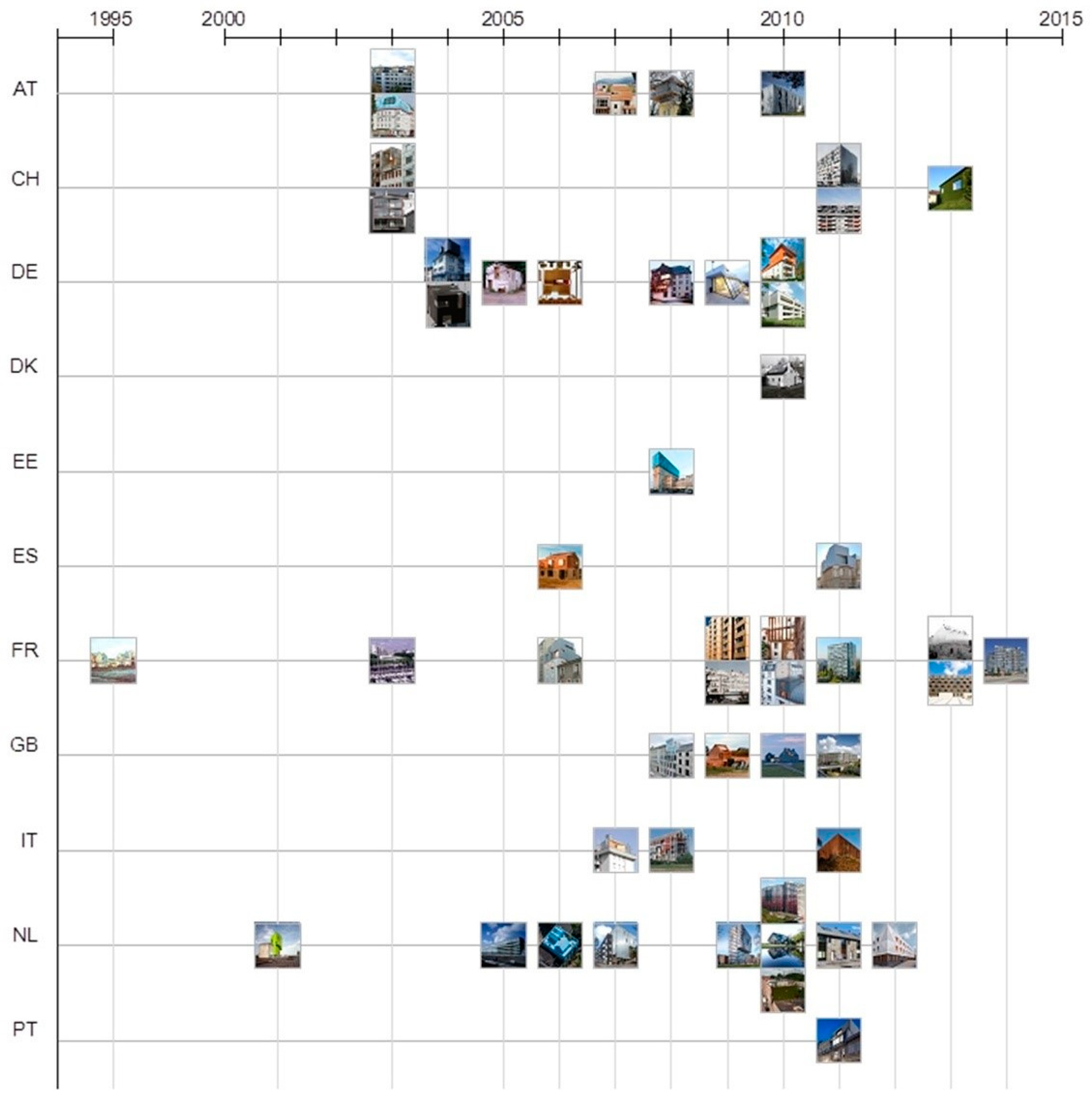
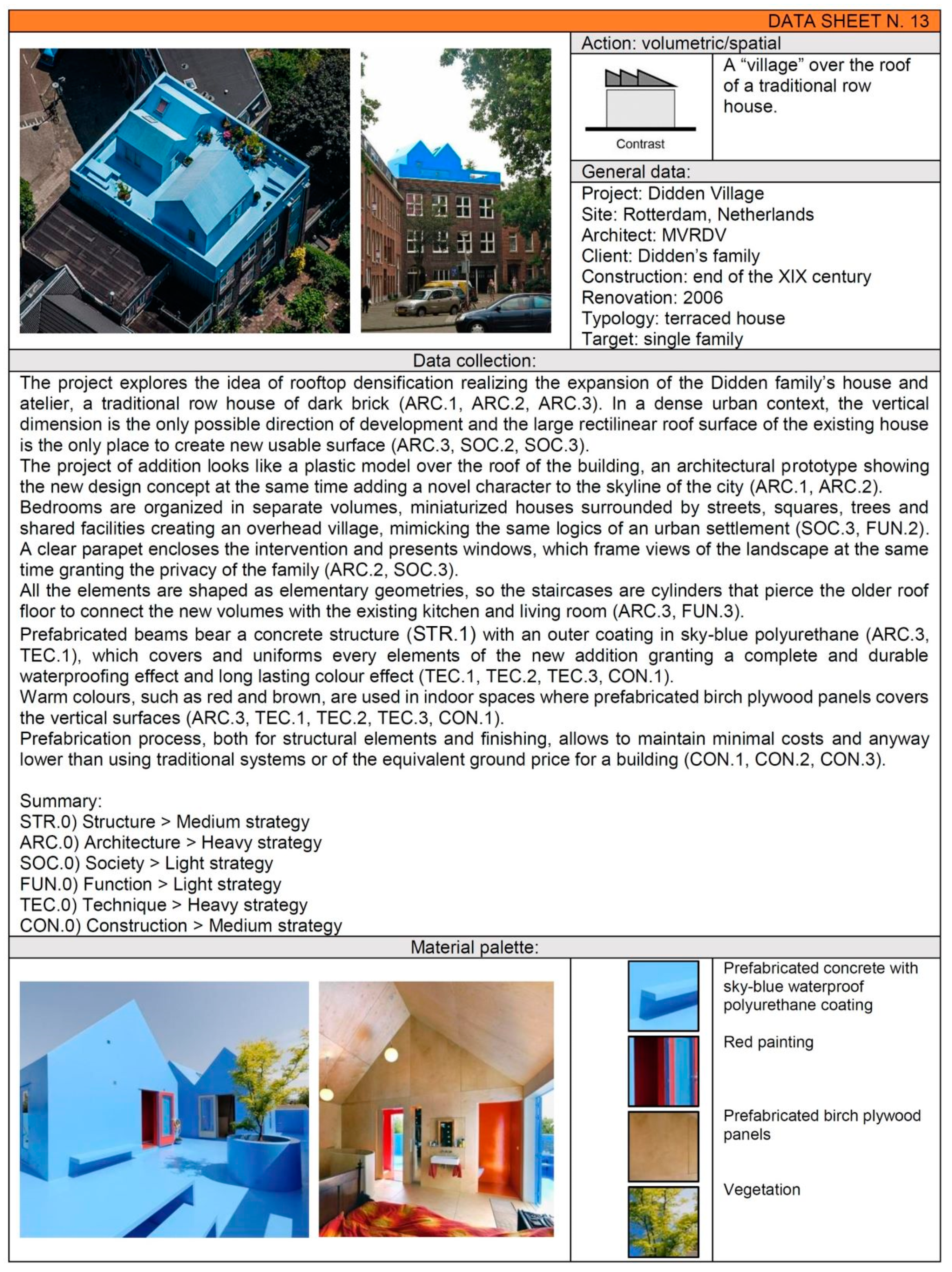


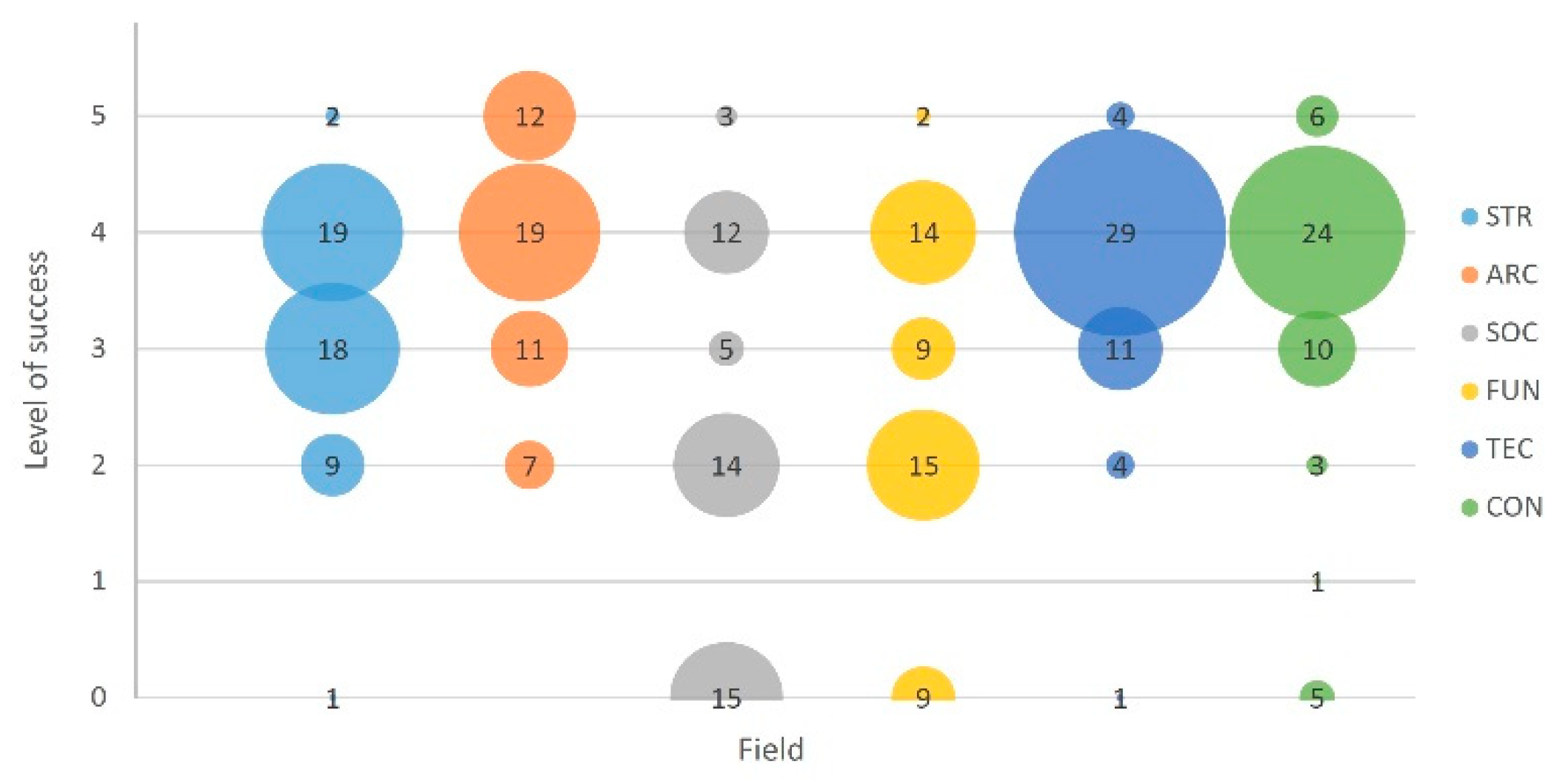
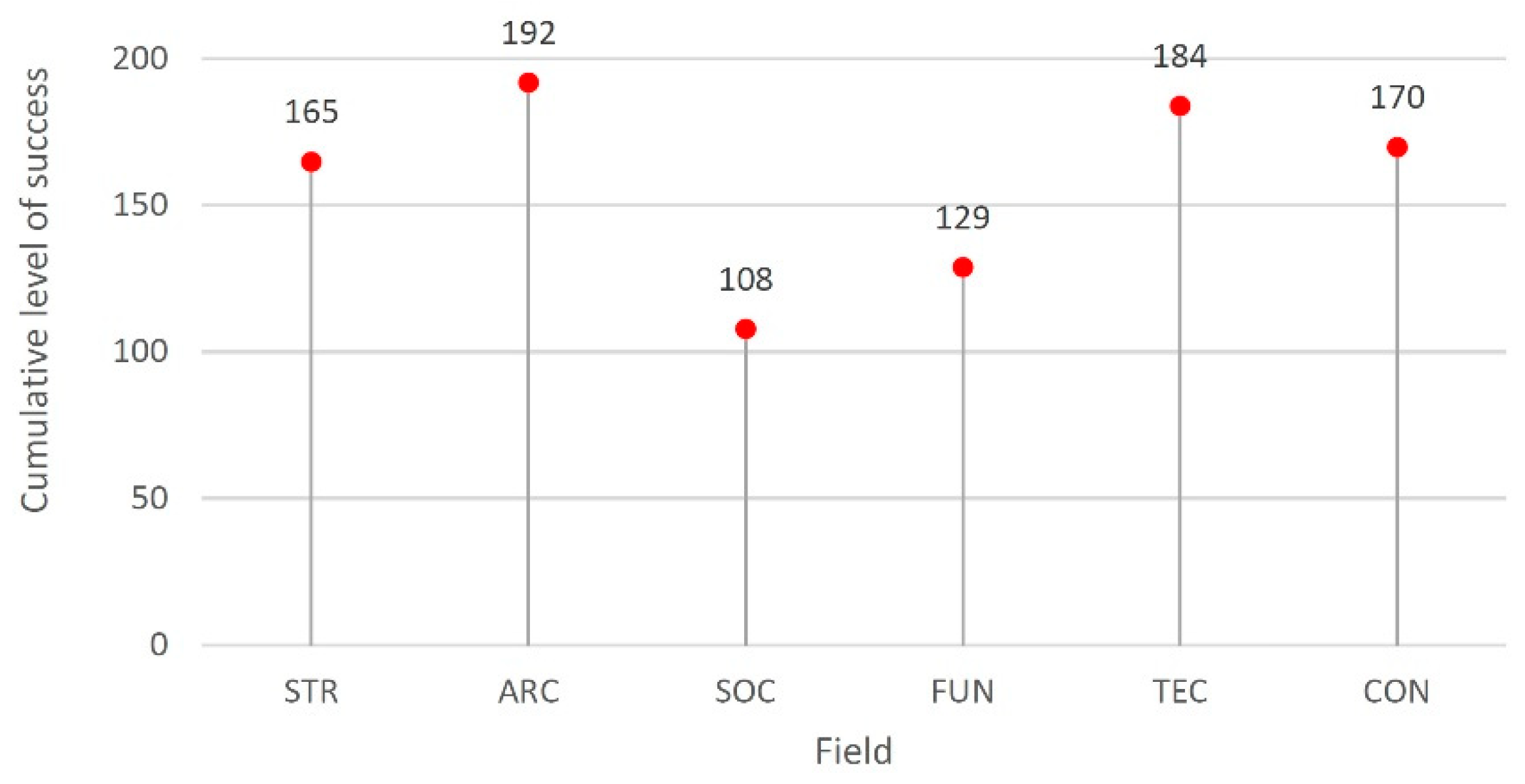
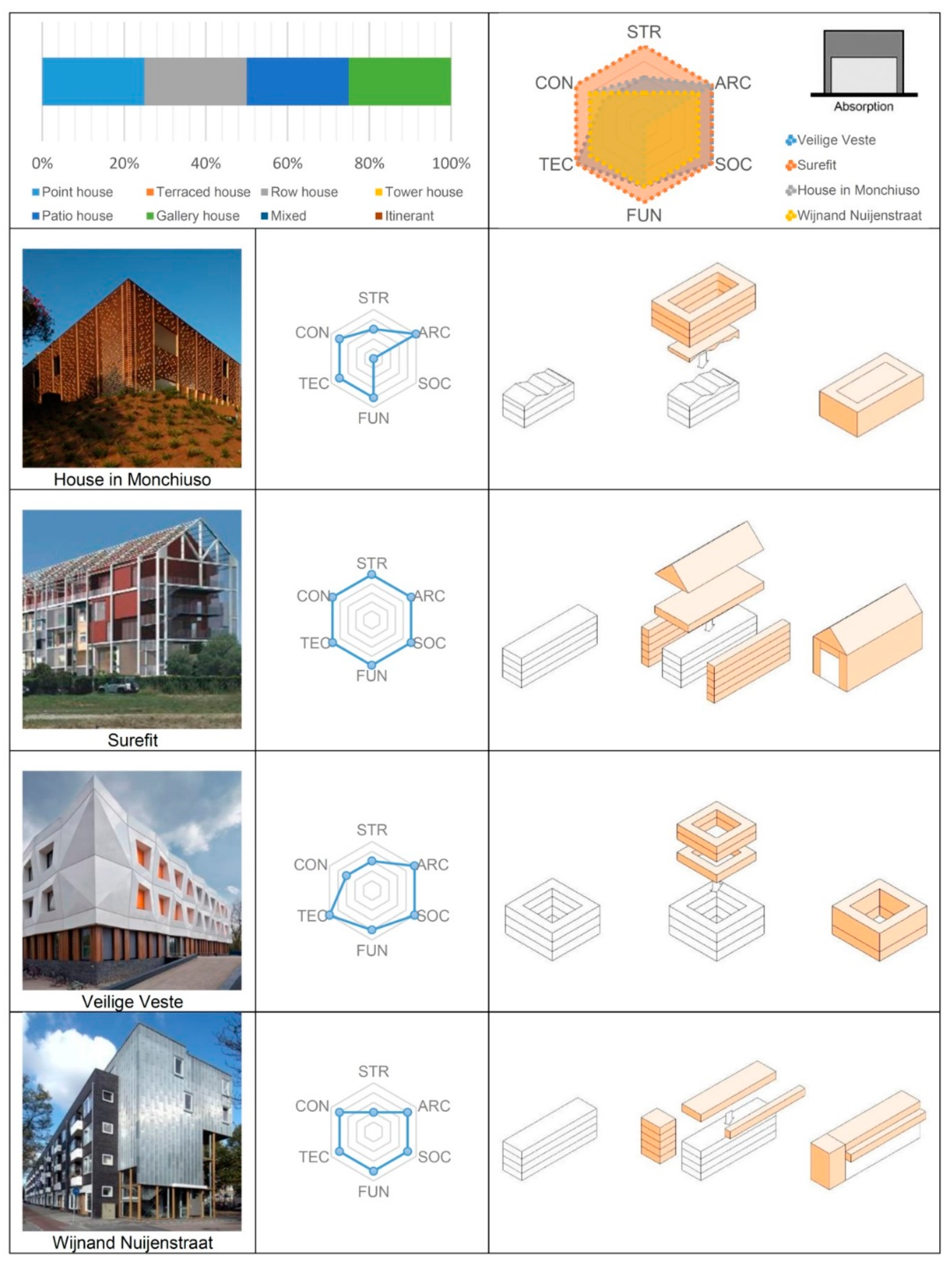

| Typology | Data Sheet | Project | Country | Year |
|---|---|---|---|---|
| Isolated | 1 | Aichinger house, Hertl Architects | Austria | 2010 |
| 2 | Dovecote Studio, Haworth Tompkins | Great Britain | 2009 | |
| 3 | Gründerzeithaus M30, Peter Zinganel | Austria | 2008 | |
| 4 | House in Morchiuso, Castelletti & Viganò | Italy | 2011 | |
| 5 | House in a house, Fischer Naumann Partnerschaft | Germany | 2005 | |
| 6 | La ruina habitada, Jesùs Castillo Oli | Spain | 2006 | |
| 7 | Maison Saignelegier, Dubail & Begert | Switzerland | 2013 | |
| 8 | Studio Posehuset, Svendborg architects | Denmark | 2010 | |
| 9 | The White house, WT architecture | Great Britain | 2010 | |
| 10 | Villa Rotterdam, Ooze | Netherlands | 2010 | |
| Terraced | 11 | Black Pearl House, Studio Rolf & Zecc | Netherlands | 2010 |
| 12 | Casa do Conto, Pedra Liquida | Portugal | 2011 | |
| 13 | Didden Village, MVRDV | Netherlands | 2006 | |
| 14 | Heliotrope over elevation, Bang architects | France | 2010 | |
| 15 | Lude House, Grupo Aranea | Spain | 2011 | |
| 16 | M03 house renovation, BAST architects | France | 2013 | |
| 17 | Neo Leo, Luderwaldt | Germany | 2006 | |
| 18 | Over elevation in Rue Daumer, Le Bihan | France | 2010 | |
| 19 | Over elevation in Rue Delbet, Le Bihan | France | 2006 | |
| 20 | Passive renovation De Kroeven 505, Aramis | Netherlands | 2011 | |
| 21 | Peugeot blocks, Lucien Kroll | France | 1995 | |
| 22 | Symbiont, FloSundK | Germany | 2004 | |
| 23 | St. Johanns-Platz 25, 4056, Wenger | Switzerland | 2003 | |
| 24 | Tayson House, Kraus & Schoenberg | Great Britain | 2008 | |
| Row | 25 | Bondy Loggias, Laurent Pillaud | France | 2009 |
| 26 | Falconer Rehabilitation, Atelier Jens Freiberg | France | 2009 | |
| 27 | Fordsiedlung der LEG, GBR arkitekten | Germany | 2010 | |
| 28 | La Golette, Atlante SA | Switzerland | 2011 | |
| 29 | Leeuw van Vlaanderen, Heren 5 | Netherlands | 2005 | |
| 30 | Minimum impact house, Julien De Smedt Architects | Germany | 2008 | |
| 31 | Republic housing complex, Castro & Denissof | France | 2003 | |
| 32 | Rue Daubin 26-27-29, Group 8 | Switzerland | 2011 | |
| 33 | Square Vitruve, Atelier Du Pont | France | 2013 | |
| 34 | Stadthaus Dreiheiligen, Daniel Fuegenshuh | Austria | 2007 | |
| 35 | Surefit, Ipostudio | Italy | 2008 | |
| 36 | Treehouse Bebelalle, Blauraum | Germany | 2010 | |
| 37 | UFO, Florian Danner | Germany | 2009 | |
| 38 | Zwinglistrasse 9 and 15, Viriden + Partner | Switzerland | 2003 | |
| Tower | 39 | Fahle House, KOKO architects | Estonia | 2007 |
| 40 | La Chesnaie, Lacaton & Vassal | France | 2014 | |
| 41 | Le Bois le Prêtre, Druot, Lacaton & Vassal | France | 2011 | |
| 42 | Over elevation, Studio Albori | Italy | 2007 | |
| 43 | Torenflat, Frowijn de Roos | Netherlands | 2010 | |
| Patio | 44 | Hellwagstraße 6-8, Lutter Heinz | Austria | 2003 |
| 45 | Park Hill, Hawkins-Brown & Egret West | Great Britain | 2011 | |
| 46 | Spitalgasse 25, Wien 9, Lutter Heinz | Austria | 2003 | |
| 47 | Veilige Veste, KAW architects | Netherlands | 2012 | |
| Gallery | 48 | Wijnand Nuijenstraat, van den Brink en Tupker | Netherlands | 2007 |
| Mixed | 49 | Dillenburgh, Heren 5 | Netherlands | 2010 |
| Codes | Explanation |
|---|---|
| STR.0) | Structure |
| STR.1) | It describes the structural characteristics of the existing building and its extension; it comprehends the materials used, the structural scheme, and the static and dynamic properties of the construction. |
| STR.2) | It indicates every reference to the structural capacities of the building before and after the intervention or to the external constraints or structural threats, such as seismic or geotechnical constraints. |
| STR.3) | It represents the condition of obsolescence, the structural deficiencies, and the retrofit actions applied on the existing construction, in connection or not with the renovation intervention. |
| ARC.0) | Architecture |
| ARC.1) | It indicates all the details connected to the historical, environmental, architectural, and urban background of the existing building. |
| ARC.2) | It is connected with the recognizability and attractiveness of the area or of the existing building, considering also the perception and the visual relationships with the surrounding environment. |
| ARC.3) | It refers to all the design choices concerning the intervention of renovation of the residential building, which influence the architectural features of the building and, in general, its perception. |
| SOC.0) | Society |
| SOC.1) | It indicates the enhancements obtained, voluntarily or not, with the application of the intervention, also considering factors such as the social cohesion and security. |
| SOC.2) | It is used for every reference to the introduction of new supplies for the target users; it is also connected to the themes of densification and participation. |
| SOC.3) | It expresses the level achieved after the intervention of renovation in relation to the social sustainability and livability of the area. |
| FUN.0) | Function |
| FUN.1) | It indicates the provision of new services and facilities for a wider group of users, the new functional quality of dwellings, and their availability for a wider target of users. |
| FUN.2) | It individuates situation of mixed use, connected both to residential function and to other relevant functions, such as education, business, healthcare, etc. |
| FUN.3) | It indicates the improvement of connections and accessibility contributing to improving the attractiveness of a wider target of residents. |
| TEC.0) | Technique |
| TEC.1) | It is used in relation to the data connected with the use and choice of materials and technologies. |
| TEC.2) | It is related to the improvement in the energy performance of the building, to the use of natural energy resources, and new technical and technological equipment. |
| TEC.3) | It is related to the life-cycle assessment of the building, including the degradation, the aging, and the maintenance plans. |
| CON.0) | Construction |
| CON.1) | It is used to indicate the construction process and approach adopted in relation to the context of the existing building. |
| CON.2) | It is related to the cost of the intervention and to any method adopted in order to limit the expenses or to capitalize the action. |
| CON.3) | It explains the construction choices and the material used to limit the construction times and, thus, the nuisance for the inhabitants and the indirect cost connected. |
| Level of Success | Field | Description |
|---|---|---|
| Unknown strategy (0 points) | Structure | Unknown strategy |
| Architecture | Unknown strategy | |
| Society | Unknown strategy | |
| Function | Unknown strategy | |
| Technique | Unknown strategy | |
| Construction | Unknown strategy | |
| Ineffective strategy (1 point) | Structure | Lack of a primary step of evaluation of the capacity of the existing building and of the external constraints; ineffective selection or use of the structural materials. |
| Architecture | Wrong or incomplete interpretation of the surrounding context; unattractive or inadequate selection of the architectural features. | |
| Society | Failure of the strategy for inadequate interpretation of the societal conditions and no participative process; degradation, crime of the area, and missing sustainability. | |
| Function | No additional services, new functions and/or accessibility patterns; no mixed use in terms of functions or target users; ineffective design and consequent use. | |
| Technique | Inadequate selection of the technology in relation to the performance and to the surrounding environment; missing attention on the sustainability of the project and on the energy performances; easy degradation of the elements. | |
| Construction | Management problems during the construction process, late delivery, and/or unforeseen indirect or direct costs. | |
| Light strategy (2 points) | Structure | Evaluation of the existing structure and minor lightweight additions, both superficial and three-dimensional. |
| Architecture | Minor modification of the architectural features of the building; relative attention to the existing context in terms of permanence of the same visual and physical relationship. | |
| Society | Interactions with limited societal groups; permanence of the same provision of dwellings and facilities. | |
| Function | Permanence of the same provision in terms of facilities and services; no new accessibility schemes. | |
| Technique | Absence of relevant enhancement of the performances of the building; the choice of materials relatively consider the maintenance, aging, and degradation processes. | |
| Construction | The construction plan is not specifically intended to reduce the construction time and costs. | |
| Medium strategy (3 points) | Structure | Partial demolitions of non-structural elements for distributive reasons with no relevant modification of the existing structures; light addition on the roof with independent structure. |
| Architecture | Increase in the interaction in the context of some modification of the appearance of the building. | |
| Society | Enhancement of the livability and sustainability of the housing estate. | |
| Function | Provision of new facilities for the existing users and societal groups; mixed use and new accessibility schemes for private users. | |
| Technique | Enhancement of the energy performance of the building with the introduction of new insulation layers or performing materials. | |
| Construction | Consideration of strategies to reduce the costs and the time during the construction process with the selection of particular processes, structures, and materials. | |
| Heavy strategy (4 points) | Structure | The structure is modified consistently in order to carry new loads and elements or as a consequent of the individuation of environmental constraints. |
| Architecture | Significant interaction or modification of the context provoked by the intervention. | |
| Society | Provision of housing for a wider societal group, often mixed, with new pattern of sustainability in the area. | |
| Function | Provision of facilities and new services for a wider societal group, often in correlation with mixed use or target, new accessibility patterns for the users. | |
| Technique | Use of prefabricated technologies, dry technologies, and/or lightweight technologies. High increase in the energy performance of the building connected with the use of natural resources. | |
| Construction | Exploitation of prefabricated construction techniques and application of innovative strategies to limit the construction time and costs. | |
| Radical strategy (5 points) | Structure | Substantial demolitions and modifications of the existing structure with addition of new consistent structural elements. |
| Architecture | Radical modification of the interaction with the context and/or substantial change of the architectural appearance of the building. | |
| Society | Consistent strategy of modification of the living standard of the area, sometimes developed with a participating design process; new users and societal groups are considered and involved. | |
| Function | Provision of new spaces, facilities, and services, often in mixed use. The accessibility results are substantially modified. | |
| Technique | Prefabricated and high-performing technologies are used to achieve the best environmental performances. New strategy for the production of energy with the use of natural resources. | |
| Construction | The construction process has radical positive effects on the reduction of costs and time; the realization of the intervention does not influence the life of the inhabitants and their activities. |
© 2019 by the author. Licensee MDPI, Basel, Switzerland. This article is an open access article distributed under the terms and conditions of the Creative Commons Attribution (CC BY) license (http://creativecommons.org/licenses/by/4.0/).
Share and Cite
Scuderi, G. Retrofit of Residential Buildings in Europe. Designs 2019, 3, 8. https://doi.org/10.3390/designs3010008
Scuderi G. Retrofit of Residential Buildings in Europe. Designs. 2019; 3(1):8. https://doi.org/10.3390/designs3010008
Chicago/Turabian StyleScuderi, Giuliana. 2019. "Retrofit of Residential Buildings in Europe" Designs 3, no. 1: 8. https://doi.org/10.3390/designs3010008
APA StyleScuderi, G. (2019). Retrofit of Residential Buildings in Europe. Designs, 3(1), 8. https://doi.org/10.3390/designs3010008




